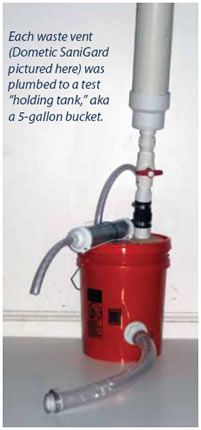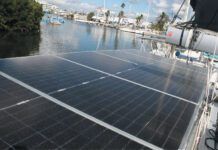
201
To create a real-world test, we assembled a series of miniature holding tanks containing sanitary waste generously supplied by a 20-pound, 5-foot pet iguana named Ziggy. This was supplemented with other sanitary waste as needed. Seawater flush was used because saltwater is known to contribute to odor.
The six tanks—5-gallon polyethylene buckets with tight lids—were fitted with 5/8-inch hose vent fittings, as required by each vent filter design. Approximately 1 gallon of waste was added to each bucket every seven days using the same 4-inch PVC pipe with a valve to provide uniform “flushes.” The buckets were shaken vigorously after each addition to simulate the movement a holding tank sees underway. The buckets were then left undisturbed for six days. Once the buckets reached 80 percent capacity—about once a month—they were emptied. Clearly our results with iguana poo may not directly correlate with the results you’d get using human waste.
We started testing the tanks, near Chesapeake Bay, in the spring and continued through the summer, with high temperatures over 100 degrees and lows to 50 degrees. Testing will continue through winter and summer 2012. On-board testing is also in progress on the Chesapeake Bay. The test boat is cruised three weeks per year and sailed or over-nighted most weekends year-round.
Although the volume for these tanks would be somewhat less than a real-world holding tank, because the tanks were not in the bilge of a boat, both average summer temperatures and diurnal temperature swings were greater, and thus thermal breathing somewhat greater. We also compared the performance of the vent filter on the test boat; the results were equivalent, indicating a fair and realistic measure of performance.
There is only one true measure of effectiveness: Does the vent stink when the head is flushed? However, as much as we might like to have calibrated noses and compared the relative foulness of the products, it was nice to have an analytical number to compare as well, so we measured gases with a meter at regular intervals.
For testing, about a half-gallon of seawater was added to the 4-inch flush pipe. This was used in place of sanitary waste so that all tanks could be tested at the same time under identical slug filling conditions. The level of hydrogen sulfide in the discharge gas was measured in the vent during this slug filling, and an olfactory observation was made, with noses about 3 inches downwind of the vent. On some trials, this was a bit hard to take. On most of the filter trials, only the faint plastic smell of new vinyl hose was noticeable.
To provide baseline and to evaluate other options, we also equipped three tanks with common venting arrangements.
• 30 inches of 5/8-inch hose. The industry standard and our experimental control.
• 30 inches of 1 1/5-inch hose. Some experts, including Raritan Engineering, recommend that oversize hoses allow enough ventilation to promote aerobic conditions and thus reduce odor to the point where no filter is needed. Incompatibility of filters with the Electro Scan treatment systems made by Raritan may be another reason for this preference. However, we got good results with enhanced ventilation, discussed below.
• Forced air. We pumped 540 ml./minute of air into one holding tank, using a simple aquarium air pump, simulating the Groco Sweet Tank System on a smaller scale. Electrical consumption for these systems is about 2.5 watts, 24 hours per day, or about 5 amp-hours per day. Not much for a boat that is plugged in to shore power or has a substantial solar system, but one more thing to be left running, unattended.






































